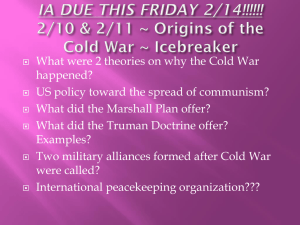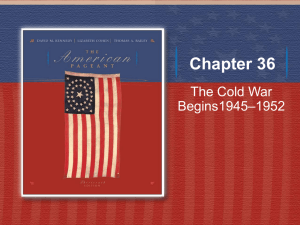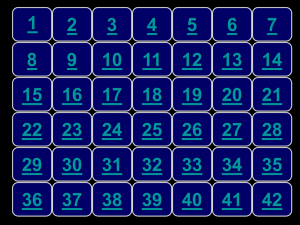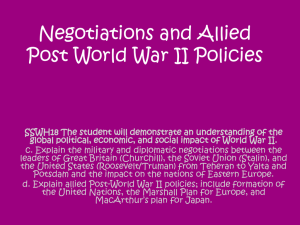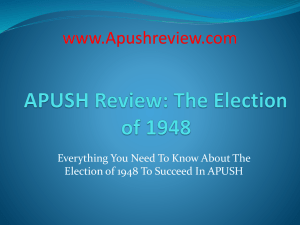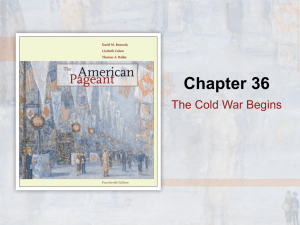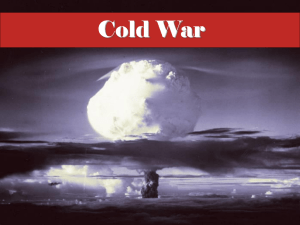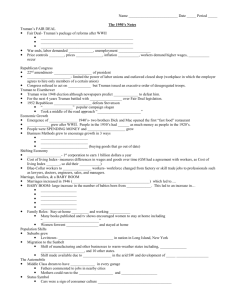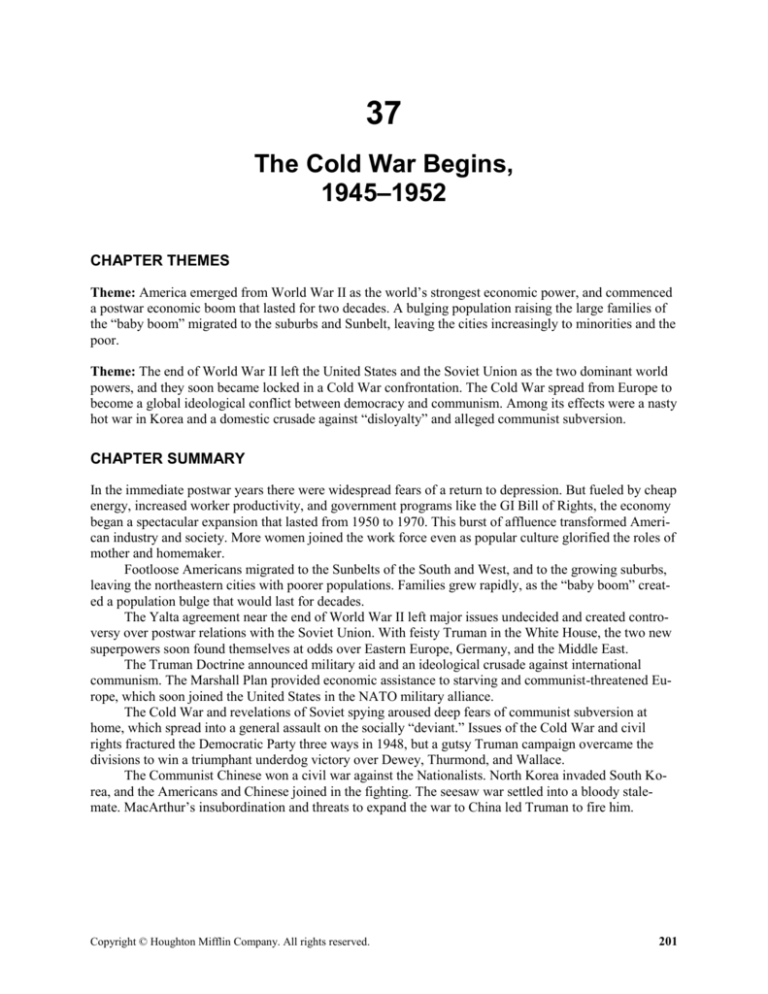
37
The Cold War Begins,
1945–1952
CHAPTER THEMES
Theme: America emerged from World War II as the world’s strongest economic power, and commenced
a postwar economic boom that lasted for two decades. A bulging population raising the large families of
the “baby boom” migrated to the suburbs and Sunbelt, leaving the cities increasingly to minorities and the
poor.
Theme: The end of World War II left the United States and the Soviet Union as the two dominant world
powers, and they soon became locked in a Cold War confrontation. The Cold War spread from Europe to
become a global ideological conflict between democracy and communism. Among its effects were a nasty
hot war in Korea and a domestic crusade against “disloyalty” and alleged communist subversion.
CHAPTER SUMMARY
In the immediate postwar years there were widespread fears of a return to depression. But fueled by cheap
energy, increased worker productivity, and government programs like the GI Bill of Rights, the economy
began a spectacular expansion that lasted from 1950 to 1970. This burst of affluence transformed American industry and society. More women joined the work force even as popular culture glorified the roles of
mother and homemaker.
Footloose Americans migrated to the Sunbelts of the South and West, and to the growing suburbs,
leaving the northeastern cities with poorer populations. Families grew rapidly, as the “baby boom” created a population bulge that would last for decades.
The Yalta agreement near the end of World War II left major issues undecided and created controversy over postwar relations with the Soviet Union. With feisty Truman in the White House, the two new
superpowers soon found themselves at odds over Eastern Europe, Germany, and the Middle East.
The Truman Doctrine announced military aid and an ideological crusade against international
communism. The Marshall Plan provided economic assistance to starving and communist-threatened Europe, which soon joined the United States in the NATO military alliance.
The Cold War and revelations of Soviet spying aroused deep fears of communist subversion at
home, which spread into a general assault on the socially “deviant.” Issues of the Cold War and civil
rights fractured the Democratic Party three ways in 1948, but a gutsy Truman campaign overcame the
divisions to win a triumphant underdog victory over Dewey, Thurmond, and Wallace.
The Communist Chinese won a civil war against the Nationalists. North Korea invaded South Korea, and the Americans and Chinese joined in the fighting. The seesaw war settled into a bloody stalemate. MacArthur’s insubordination and threats to expand the war to China led Truman to fire him.
Copyright © Houghton Mifflin Company. All rights reserved.
201
202
Chapter 37
DEVELOPING THE CHAPTER: SUGGESTED LECTURE OR DISCUSSION TOPICS
Explain the changes in American economic development since World War II. The emphasis might
be on America’s uncontested postwar economic domination and on the eventual weakening of the
heavy-industrial base and the turn to other economic activities.
REFERENCE: John
Patrick Diggins, The Proud Decades: America in War and Peace, 1941–1960
(1988).
Explain the complex causes of the Cold War. The emphasis might be on the vacuum of power created by the destruction of Europe and the decline of Britain, as well as on the specific ideological
and political battles over Poland, Germany, and Greece.
REFERENCES:
Daniel Yergin, Shattered Peace (1977); Melvyn P. Leffler, A Preponderance of Power: National Security, the Truman Administration, and the Cold War (1992).
Examine the rise of suburbs in relation to the changes in postwar economic, social, and racial life.
Consider suburbia as an expression of both rising affluence and geographical mobility (especially in
the South and West). Perhaps consider some of the critics and defenders of the suburbs in the
1950s.
REFERENCE: Kenneth Jackson,
Crabgrass Frontier (1986).
Analyze the connection between the Cold War abroad and the hunt for subversion at home, perhaps
focusing on the difference between the attacks on actual Soviet spies and the broader attack on all
American Communists and the use of the “Communist” charge as a way to smear and suppress all
sorts of people with unconventional views and lifestyles.
REFERENCE:
Richard Fried, Nightmare in Red (1990); Ellen Schrecker, Many Are the Crimes
(1998).
FOR FURTHER INTEREST: ADDITIONAL CLASS TOPICS
Contrast the economic, social, and cultural life of a “typical” family of the 1940s and 1950s and a
similar family of the 1990s.
Examine the significance of divided Germany and the “captive nations” of Eastern Europe in the
Cold War.
Analyze one or more of the key subversion cases—for example, the Hiss or Rosenberg cases. Consider how they became decades-long symbols of Cold War divisiveness.
Discuss the frustrations of Korea as a “limited” and stalemated war. Special emphasis could be
placed on the firing of MacArthur.
Copyright © Houghton Mifflin Company. All rights reserved.
The Cold War Begins, 1945–1952
203
CHARACTER SKETCHES
Benjamin Spock (1903–1998)
Spock was the pediatrician whose child-rearing guide Baby and Child Care has been used by millions of
American parents.
A 1929 graduate of Columbia Medical School, Spock became a well-known New York pediatrician, serving celebrities such as Margaret Mead. He wrote Baby and Child Care while serving in the navy
during World War II. The book has sold over 25 million copies—the best-selling original title ever published in the United States.
Although the book was later criticized by conservatives as “permissive,” it actually represented only a moderate reaction against the rigid feeding schedules and very strict discipline urged by child-care
experts of the 1920s and 1930s. Spock believed that parents should set behavioral guidelines for children,
and encouraged them to “trust your instincts.”
Criticism of Spock increased when he became an active opponent of the Vietnam War in the 1960s.
He was indicted and convicted for encouraging draft resistance, but the conviction was overturned on appeal in 1969. In 1972 he ran as the presidential candidate of the small People’s party. Even when he engaged in his radical political activities, his image was that of a kindly, grandfatherly gentleman.
Quote: “I may as well let the cat out of the bag as far as my opinion goes and say that strictness or permissiveness is not the real issue. Good-hearted parents who aren’t afraid to be firm when necessary can
get good results with either strictness or moderate permissiveness.” (Baby and Child Care, 1946)
REFERENCE: Thomas
Maier, Dr. Spock: An American Life (1998).
Harry S Truman (1884–1972)
Truman was the Missouri haberdasher and machine politician who came to be regarded as one of the
great American presidents.
The S in the middle of Truman’s name did not stand for anything. Both of his grandfathers had S
names, so his parents just gave Harry the letter rather than choose either one.
Being very nearsighted, even as a boy, Truman spent much time playing the piano and reading history. His hero in American history was Andrew Jackson.
Truman worked on the family farm and at many odd jobs before becoming a popular artillery officer in World War I—an experience that remained one of the highlights of his life. The men’s clothing
store he started in 1919 failed two years later, and he then began his career in machine politics. Judge
Truman controlled a large patronage army but was never involved in the widespread corruption that surrounded him in Kansas City’s Pendergast machine.
His quick temper and blunt-spoken ways were legendary. He often wrote angry letters to critics but
only occasionally mailed them. His most famous public outburst came against a music critic who disliked
his daughter Margaret’s singing.
Quote: “The Republicans work for the benefit of the few bloodsuckers who have offices in Wall Street.
This is a crusade of the people against the special interests, a crusade to keep the country from going to
the dogs. You back me up and we’ll win that crusade.” (Campaign speech, 1948)
REFERENCE:
David McCulloch, Truman (1992).
Copyright © Houghton Mifflin Company. All rights reserved.
204
Chapter 37
George Kennan (1904– )
Kennan was the American diplomat and ambassador to Russia who is credited with formulating the containment policy but later became a critic of many American Cold War policies, including Vietnam.
There was a distantly related nineteenth-century George Kennan whose career eerily paralleled that
of the twentieth-century Kennan. Both were born on the same day, and both men became the leading
American Russia scholars and diplomats of their time.
Kennan served as a U.S. diplomat in Germany and Riga, Latvia, before World War II. He became a
scholarly expert on Russia, and his telegrams to Washington, based partly on his close observations of
Stalin and the Russians, set out the basic principles of containment even before he wrote his “X” article in
Foreign Affairs.
Kennan’s brief term as ambassador to the Soviet Union in 1952 was cut short when the Soviet government expelled him, supposedly for critical remarks he had made about the communist rulers. Kennan
later objected to the “militarization” of American foreign policy and ironically became in the 1960s and
1970s probably the most influential critic of the American Cold War policies he is credited with initiating.
Even in his eighties and nineties, Kennan remained a highly respected analyst of American foreign
policy. He also wrote several volumes of personal memoirs that were praised for their thoughtfulness and
literary artistry.
Quote: “There is nothing—I repeat nothing—in the history of the Soviet regime which could justify us in
assuming that the men who are now in power in Russia, or even those who have chances of assuming
power within the foreseeable future, would hesitate for a moment to apply this power against us if by so
doing they thought it would materially improve their power position in the world.” (Telegram to Washington, 1945)
REFERENCE:
George F. Kennan, Memoirs, 1925–1950 (1967); David Meyers, George Kennan and the
Dilemmas of U.S. Foreign Policy (1998); A biography of Kennan by historian John Lewis Gaddis forthcoming.
Thomas Dewey (1902–1971)
Dewey was the losing Republican presidential candidate in 1944 and 1948.
Dewey originally pursued a career in music, but enjoyed little success as an opera singer in Chicago. He then turned to law. In 1931 he became the youngest ever United States attorney. In 1935 Dewey
became a special prosecutor for racketeering, and gained widespread attention for going after such notorious gangsters as Dutch Schultz and Lucky Luciano. His career as a relentless prosecutor formed the basis
for several Hollywood movies.
Dewey grew his signature mustache to please his wife. His advisers constantly urged him to shave
it off, saying it made him look sinister, but he refused to do so. Although he was lively and pungent in
private, Dewey was obsessed with maintaining a proper image, and often came across as stiff and formal
in his public appearances. He never allowed himself to be photographed except in a tie and vest.
Dewey remained a formidable power in Republican politics even after his two presidential defeats,
and helped engineer the nominations of Dwight Eisenhower in 1952 and Richard Nixon in 1960. Many
conservative “Taft Republicans” resented him as a leader of the “Eastern Establishment.”
Quote: “I do not know about the accommodations at the White House for the family.…There is of course
no rush about it.” (Letter, fall 1948)
REFERENCE:
Richard Norton Smith, Thomas E. Dewey and His Times (1982).
Copyright © Houghton Mifflin Company. All rights reserved.
The Cold War Begins, 1945–1952
205
QUESTIONS FOR CLASS DISCUSSION
1. Which development caused the greatest change in American society in the immediate postwar years:
increased affluence, the migration to the suburbs, the entry of women into the workforce, or the “baby
boom”?
2. Was the primary threat from the Soviet Union military or ideological—that is, was the danger that the
Soviet army would invade Western Europe or that more and more people in Europe and elsewhere
would be attracted to communist ideas?
3. Were there any legitimate concerns behind the “red-hunting” anticommunism of the late 1940s and
early 1950s? How were McCarthy and others able to turn the search for spies and subversives into an
assault on freethinkers, adulterers, homosexuals, and others deemed “different” in some way?
4. Was Truman right to fire MacArthur when and how he did? What would have happened if MacArthur
had gotten his way and expanded the conflict with the Chinese?
MAKERS OF AMERICA: THE SUBURBANITES
Questions for Class Discussion
1. To what extent was the migration to suburbia a “flight from” the city and its problems, and to what
extent was it a “flight to” a vision of a new “pastoral” way of life?
2. Were the new problems that accompanied the early growth of suburbia, e.g., traffic congestion, pollution, racial segregation, and the confinement of women to domestic roles a result of the suburban migration itself? Or would they have come to the fore even if most postwar Americans had continued to
live in central cities?
Suggested Student Exercises
Examine the maps of four or five major metropolitan areas of the United States to discover the geographical relations of central cities to suburbs. Looking at maps over the course of several decades
(e.g., from 1950, 1965, 1985, and 2000), examine the growth of suburban settlement patterns, and
consider their relation to patterns of railroads, highways, and mass transit in areas where it has a
prominent role (e.g., Washington D.C., Chicago, Atlanta, San Francisco).
Select a dozen or more major American corporations, and determine the location of their corporate
headquarters in relation to central cities and suburbs. Consider the extent to which the traditional
pattern of “live in the suburbs, work in the city” has been altered in some metropolitan areas, and to
what extent it remains in place.
EXPANDING THE “VARYING VIEWPOINTS”
Walter LaFeber, America, Russia, and the Cold War, 1945–1984 (1985).
A view of the United States as primarily responsible for the Cold War:
Copyright © Houghton Mifflin Company. All rights reserved.
206
Chapter 37
“Having failed to budge the Russians in face-to-face negotiations, even when backed by atomic
bombs, the State Department next tried to buckle Stalin’s iron fence with economic pressures.…More important, it made American officials ponder the awful possibility that Stalin’s ambitions included not only strategic positions in Eastern Europe, but the imposition of Communist
regimes upon Asia and the Middle East. Stating the Soviet dictator’s alternatives in this way no
doubt badly distorts his true policies.…Stalin’s thrusts after 1944 were rooted more in the Soviets’
desire to secure certain specific strategic bases, raw materials, and above all, to break up what Stalin considered to be the growing Western encirclement of Russia.…However, American officials
saw little reason to worry about such distinctions.”
John Lewis Gaddis, The United States and the Origins of the Cold War (1972).
A view of the Cold War as caused primarily by Soviet aggression:
“If one must assign responsibility for the Cold War, the most meaningful way to proceed is to ask
which side had the greater opportunity to accommodate itself, at least in part, to the other’s position, given the range of alternatives as they appeared at the time. Revisionists have argued that
American policy-makers possessed greater freedom of action, but their view ignores the constraints
imposed by domestic policies.…The Russian dictator was immune from pressures of Congress,
public opinion, or the press.…This is not to say that Stalin wanted a Cold War.…But his absolute
powers did give him more chances to surmount the internal restraints on his policy than were available to his democratic counterparts in the West.”
QUESTIONS ABOUT THE “VARYING VIEWPOINTS”
1. How does each of these historians see American and Soviet motives in the Cold War?
2. On what basis does each assign primary responsibility for initiating Cold War conflicts?
3. How would each of these historians likely interpret the confrontation over Greece and the Truman
Doctrine?
Copyright © Houghton Mifflin Company. All rights reserved.

